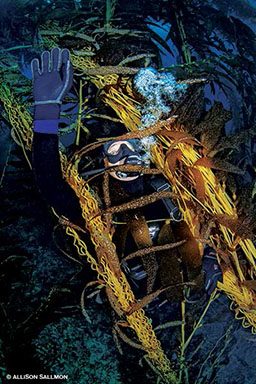The Divers
On his first-ever night dive, Sam, an uncertified and inexperienced diver with fewer than 15 lifetime dives, descended to catch lobsters with two other uncertified divers (Dave and Tim). The three descended, while a fourth diver (Ron) planned to freedive and assist with hauling in the anticipated lobster catch. A fifth diver (Eric) remained on the boat. (Note: All names are fictitious.)
The Incident
Dave’s tank slipped out of his BCD strap five minutes into the dive. He alerted Tim of the issue and signaled that he was going to surface to adjust his gear. Dave and Tim went to the surface, while Sam, unaware of their decision, continued with the dive. When Dave and Tim returned to the boat, they realized Sam had not followed them and were unsure of his location. They conducted a brief surface search and concluded he must still be at depth. While freediving, Ron saw Sam entangled in kelp at approximately 25 feet. Sam was still wearing his mask, and his regulator was in his mouth. He was conscious and fighting to free himself from the thick kelp.

Sam began to panic, causing him to flail and become even more entangled. After several unsuccessful attempts to free Sam from the thick kelp, Ron returned to the surface and alerted the others that Sam was entangled and needed help. Eric responded with scuba gear from the boat. Unfortunately, by the time Eric got there, Sam was no longer wearing his mask, his regulator was not in his mouth, and he was not breathing. Eric cut Sam free and brought him to the surface. Another boat that had heard the distressed calls for help was there to pull Sam out of water. CPR was started immediately, and Sam was transported to a local hospital, where he was pronounced dead.
Fatality Analysis
Understanding the root causes and the series of events leading to a dive fatality is important for the prevention of future incidents. Investigators recovered the dive gear, which they tested and found to be working properly. The tank contained more than 2,000 psi on recovery, indicating that Sam did not run out of air; however, his regulator was found out of his mouth when he was recovered.
The trigger in this case was kelp entanglement, which made this dive an emergency and began the chain of events that led to the fatality. Sam’s panic served as the disabling agent, causing him to engage in irrational behavior that did not help to resolve the entanglement and led him to drop his regulator. Losing his regulator caused him to suffer asphyxia and drown.
Discussion
The decedent, Sam, was not a certified diver. He had some previous dive experience, but he lacked proper training and had never conducted a night dive before the fatal dive. Dave and Tim also lacked formal training and certification even though they had more experience. Formal scuba training through certifying agencies equips divers with knowledge along with the skills necessary for safe diving. Training prepares a diver to respond calmly and confidently to emergency situations. Diving that involves unique risks — in this case, night diving, lobster hunting and kelp-forest diving — requires additional training, preparedness and appropriate equipment. Acquiring certifications for such environments is recommended.
Diving in kelp requires streamlined equipment to reduce the risk of entanglement and a cutting tool to resolve possible entanglement. Sam was not carrying a cutting tool, and it is unknown whether his equipment was streamlined. In addition to being responsible for one’s own safety by obtaining the appropriate training for specifically risky environments, it is also wise to dive with a divemaster and/or rescue diver trained to react in emergency rescue situations.
Buddy diving means diving in pairs, not in an odd-numbered group. Pair diving is the best practice to prevent buddy separation. In a group of three or more, miscommunication among dive buddies is more likely even for trained divers, because it can be unclear who has been in communication with which buddy. In this incident Dave and Tim communicated the ascent to one another, but Sam remained unaware of the situation. This may have contributed to Sam’s panic because he could not locate others to help free him from the kelp.
A medical emergency or equipment failure did not trigger this incident. It was caused by a foreseeable factor for which the divers were not prepared. Although a lack of formal training may have contributed to this fatal incident, there are other valuable lessons in this tragedy that certified divers should not overlook.
Reference
Denoble PJ, Caruso JL, Dear GdL, Pieper CF, Vann RD. Common causes of open-circuit recreational diving fatalities. Undersea Hyperb Med. 2008; 35(6):393-406.
© Alert Diver — Q4 Fall 2014